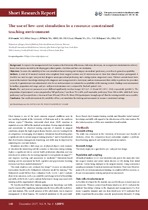| dc.contributor.author | Mwandri, M. | |
| dc.contributor.author | Walsh, M. | |
| dc.contributor.author | Frantz, Jose M. | |
| dc.contributor.author | Delport, R. | |
| dc.date.accessioned | 2017-12-13T08:48:21Z | |
| dc.date.available | 2017-12-13T08:48:21Z | |
| dc.date.issued | 2017 | |
| dc.identifier.citation | Mwandri, M. et al. (2017). The use of low-cost simulation in a resource-constrained teaching environment. African Journal of Health Professions Education, 9(4): 168 - 170 | |
| dc.identifier.issn | 2078-5127 | |
| dc.identifier.uri | http://dx.doi.org/10.7196/AJHPE.2017.v9i4.829 | |
| dc.identifier.uri | http://hdl.handle.net/10566/3324 | |
| dc.description.abstract | BACKGROUND. To improve the management of chest trauma at the University of Botswana, Gaborone, Botswana, we incorporated simulation into a theorybased
chest trauma module by developing procedural guides, checklists and low-cost simulation.
OBJECTIVES. To assess the suitability of low-cost simulation-based training and its impact on students’ proficiency, as well as its general acceptability.
METHODS. A total of 39 medical students who completed their surgical rotation and 20 intern doctors in their first clinical rotation participated. A
checklist was used in a pre- and post-test design to assess procedural proficiency, and a rating system categorised scores. Thirteen content-based items
assessed the students’ knowledge relating to the diagnosis and management of a chest injury and one item assessed their ability to perform the procedure
correctly. A questionnaire was administered after the second assessment to evaluate the acceptability of the training module. Findings were summarised
by median, proportion and range, and pre- and post-test outcomes were compared by Student’s paired t-test.
RESULTS. Pre- and post-test assessment scores differed significantly (median (range) 11.3 (4.5 - 21.0) and 19.5 (15.5 - 23.0), respectively (p<0.001)). The
proportions of participants’ scores categorised as ‘full proficiency’ rose from 7% to 42%, and ‘reasonable proficiency’ from 30% to 60%, while both ‘some
proficiency’ and ‘poor proficiency’ decreased from 50% and 20% to 0%. Most (93%) participants ‘strongly agreed’ that the training module was acceptable.
CONCLUSION. Our results demonstrate the suitability of low-cost simulation for training and assessment in resource-constrained settings. | en_US |
| dc.language.iso | en | en_US |
| dc.publisher | Health and Medical Publishing Group (HMPG) | en_US |
| dc.rights | This open-access article is distributed under
Creative Commons licence CC-BY-NC 4.0. | |
| dc.subject | Surgical skill | en_US |
| dc.subject | Low-cost simulation | en_US |
| dc.subject | Chest injury | en_US |
| dc.subject | Surgical skills assessment | en_US |
| dc.subject | Low-middle-income-countries | en_US |
| dc.title | The use of low-cost simulation in a resource-constrained teaching environment | en_US |
| dc.type | Article | en_US |
| dc.privacy.showsubmitter | FALSE | |
| dc.status.ispeerreviewed | TRUE | |

